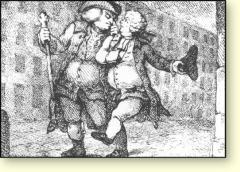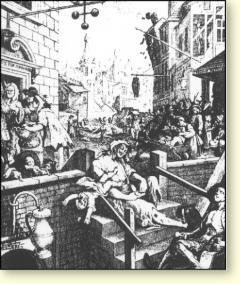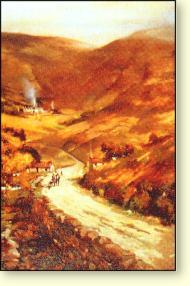The original Scotch whisky was malt whisky – often big, soupy, strong and smoky from the peat-fuelled fires used to dry the malt. Batches from a single still could vary, styles from one village to another would always vary.
Whisky was as intrinsic a part of Gaelic life as bread and had a surprising range of invaluable applications. It kept out the cold, set up the traveller for his journey and soothed him when it was over, punctuated social meetings and sealed business discussions. The scope beyond its being a mere accompaniment to other things was extraordinary. Whisky tempered fever, acted as an anaesthetic, especially in childbirth, and disinfected sword-cuts. It was even used with oatcakes to serve Communion for want of wine and bread at the Battle of Culloden.
The ancient Chinese, Egyptians, Greeks and Romans knew about distillation but the crude spirits they produced were not drunk but used as solvents and unguents. Irish monks may well have had the secret of whisky as a restorative drink in the sixth or seventh centuries AD and took it with them when they travelled across to Scotland and into Europe as missionaries. A distillate was a mysterious liquid and was known to preserve dead tissue immersed in it, a property that seemed to associate it with life itself. This ‘water of life’ was aqua vitae in Latin, the lingua franca of European scholars at the time, and the name has come down to the modern day. Given the Irish connection, however, aqua vitae may well be the translation from the Gaelic – usque baugh in Irish and uisge beatha in Scots – rather than the other way around.

Boswell and Johnson clearly enjoyed their trip to Scotland. This illustration from Boswell’s Journal shows the pair walking "arm-in-arm up the High Street to my home in James Court" in Edinburgh.
|
The first written reference to whisky in Scotland is from 1494 when a listing of ‘eight bolls of malt to Friar John Cor wherewith to make aquavitae’ appears in the Scottish Exchequer Rolls. However whisky had probably already been made for centuries by this time, documentary evidence for it having gone up in smoke in the frequent wars and feuds that typified the era. By the time of good Friar John, whisky was already a developed product, drunk by kings and nobles and, clearly, made in monasteries by monks who were most likely the expert distillers of the day.
There were three qualities of spirit in the days of more primitive equipment, additional distillations endowing more refinement and alcoholic strength. Simplex was distilled twice, composita three times, and perfectissima four times. No whisky is distilled four times today because modern equipment removes the need to do so. Very few producers persevere with three runs and where it is still carried out the main purpose is to preserve the house style of the whisky.
In Highland homes whisky was drunk three times a day partly as a medicinal tonic and partly in the way we take coffee-breaks today. Until recently distilleries carried on a similar routine whereby workers were given three drams daily in the course of their shift as a modest, but universally appreciated, perk. Dr. Johnson enjoyed the whisky served to him during his Highland jaunt with Boswell in 1773 even if the hour in the day surprised him. ‘Not long after the dram’, he later wrote, ‘may be expected the breakfast.’
There was no large-scale production in the Highlands. Whisky making was associated with the home much as baking a cake is today so quantities produced were in proportion to needs. Whisky was also made for sale on a part-time basis by farmers who usually grew barley in addition to other staples like wheat, oats, potatoes, turnips, and so on. They, like everyone else, had access to local peat for fuel and the wonderfully clear water from the burns. Barley could be steeped in any open container or in a pit in the ground; malt dried in a small kiln over a peat fire; the copper worm coil from the tiny battered still would sit in the cold flow of the burn to condense the vapours and the spirit would run into a small cask.
In 1707, Scotland surrendered its political independence in the Act of Union with England and the London Parliament took over the role of the Scottish House in Edinburgh. Imagine, then, the Highlanders’ consternation when, with the ink on the document scarcely dry, both malt and whisky became taxable.

The evils brought about by the availability of (untaxed) gin in London are portrayed in this etching by William Hogarth, 1751.
|
In London, primitive gin was made and sold in one house in every four; the death rate, swollen by uncontrolled gin drinking, overtook the birth rate; all restrictions on gin distilling were removed so that English landowners’ yearly overproduction of wheat could be absorbed. Yet they decided that it was whisky that had to be taxed!
The Gaels continued to produce their whisky and only very rarely did they pay any duty on it. Ironically, the roadways built throughout the Highlands to enable government soldiers to get into potentially troublesome areas also enabled the smugglers to get their whisky out and down to the bigger markets in the south where demand outstripped supply. In 1777 there were eight licensed distilleries in Edinburgh and an estimated 400 unlicensed stills. The quality of the licensed product fell right away because distillers had to cut corners massively to pay grotesque duties on their production.
Successive governments could not make up their minds whether they wanted to proscribe whisky distilling or enjoy the revenue it could produce; all through the 18th century and for the first two decades of the 19th, they got it completely wrong. Smugglers’ whisky, meanwhile, was of extremely good quality. The illicit distillers had access to the best of raw materials and few overheads. Their whisky was home-made in the best sense and the wholesome product they distilled was the basis for the high standards in the industry.
Whisky was for long drunk as the water-white liquid that ran off the still and there was no reason to think that it might improve in any way if stored. Indeed no doubt it was often even drunk when still warm from the distillation run. Someone will have eventually noticed that whisky from a barrel that had lain unused for a year or so – perhaps an unsold or forgotten puncheon – had lost some of its fire and acquired extra flavour just from its time in the oak container. It was an important discovery whenever it took place, and today Scotch whisky is required by law to age in wood, which means oak.

Misty smoke at Glengoyne dries the malt, but in this distillery the smoke is not allowed to infuse the ingredients.
|
With the costs of the Napoleonic Wars to meet at the beginning of the 19th century, London had a few more tries at wresting revenue from whisky before the Duke of Gordon suggested new and fair legislation that would both make distilling viable as a business and yield revenue through reasonable levels of duty. The Excise Act was passed in 1823 and there was an Apache charge of applicants for licences. Many of the newly respectable distillers were former smugglers and many of the new distilleries were built on the old illicit production sites. Die-hard smugglers burned down the distilleries of a few of the operators who had ‘gone legit’ and George Smith, later the creator of The Glenlivet whisky, chose to wear a pair of hair-trigger pistols in his belt for some time into the new era. The 1823 legislation was a success, however, and smuggling died out almost completely over the following decade. Many of the distilleries that were built in the 1820s were rebuilt towards the end of the 19th century and this, in turn, is why so many attractive Victorian distilleries have come down to us towards the end of the 20th century.
Scotch has made the best of the opportunities that came its way. It filled the gap created in the 1870s when cognac vanished due to the phylloxera bugs wiping out the Charentes vineyards. Blends were marketed that brought out the best that malt whisky had to offer – i.e. retaining the flavours and aromas, lightening the pungency and giving it consistency. This beat off the threat of distillers in Ireland who refused to blend grain and malt whiskies. In 1909 a Royal Commission, having deliberated for nearly 18 months, decided that grain spirit could indeed be described as whisky and blended Scotch continued to sweep everything before it in becoming the world’s favourite drink. Now things have turned full circle with the interest being shown in the individual malt whiskies produced by each distillery. We have the added advantage today of access to a wide range of bottled single malts instead of just that from the distillery nearest to where we live.